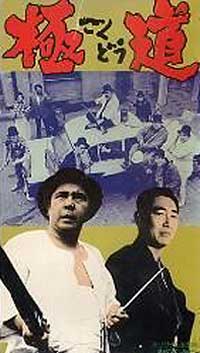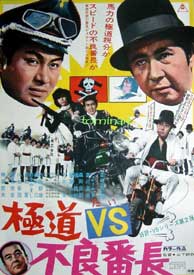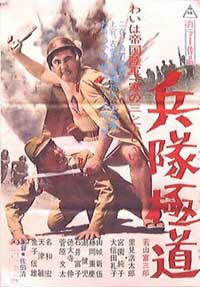 There were eleven films in the Gokudo series starring Tomisaburo Wakayama as an Osaka street hoodlum who rises in the yakuza underground. The first two episodes form a single brutal, serious gangster epic, with a tremendous supporting cast including Koji Tsuruta, Bunta Sugawara, & Minoru Ohki. There were eleven films in the Gokudo series starring Tomisaburo Wakayama as an Osaka street hoodlum who rises in the yakuza underground. The first two episodes form a single brutal, serious gangster epic, with a tremendous supporting cast including Koji Tsuruta, Bunta Sugawara, & Minoru Ohki.
When these films were debuting with subtitled 35 mm prints in west coast Japanese American cinema houses of the late 60s & early '70s, they were called "The Outsider Series" though today it is best known by its Japanese name & is called the Gokudo series.
The word "Gokudo" indicates someone living outside the normal social bounds & in the fast lane. It is used interchangeably with "Yakuza" to mean a gangster. A Gokudo often has a heroic posture, but applying the term to Tomisaburo Wakayama's character of Sei Shimamura is ironic, since he is a thug (gurentai) who doesn't really fit the Gokudo image, which should be the image that Koji Tsuruta affects in the first episode.
Gokudo (The Fast Liver aka The Outsider aka The Outlaw, 1968) & Kaettekita Gokudo (Gokudo Returns aka Return of the Outsider, 1968). A much more serious pair of films than further episodes were to be, Shimamura is a violent street thug who joins the yakuza & is merciless & unscrupulous on his rise, lacking any sense of either duty or chivalry. When imprisoned, he is repeatedly transferred from one prison to another, because no one can handle him.
Although not void of humor, it is not a comedy & the character doesn't begin to be fun-loving or likeable until the series veers onto another path with the third episode.
With the third installment & a new director (Kiyoshi Saeki) with a different vision for the series, Heitai Gokudo (Soldier Gokudo, 1968) brought satire comes to the fore, & Shimamura gained an edge of roguish charm he previoiusly lacked.
The story opens in Osaka, 1937, establishing the character of Shimamura as a gambling boss (oyabun). He has been drafted, & the fate of his gang does not look good if he must go away to war.
Despite the humorous intent, the plot gets increasingly grim as the complications unfold. One of the subplots is the story of Chikako (Junko Miyazono), a sweet school girl who is railroaded into prostitution by her brother's villainous gambling boss. Shipped to Manchuria as a soldiers' "comfort bride," she becomes a heroin addict, trying to keep her brother from learning what has happened to her, what his own oyabun has made of her instead of sending her to college as was promised. The grotesqueness of this & other plot threads pretty much preclude effective comedy except in the early scenes of character establishment.
The fight choreography is workmanlike but entertaining, though full use of characters is never achieved. When Shimamura ended up in the Japanese military prison in China, he met a series of potentially interesting characters, such as Circus, a speicalist in tightrope wealking. This character dies without his special talent ever being incorporated into the story. The characters Fist (a boastful karate fighter) & Knife (who describes himself as "a cook & a killer") meet heroic ends without once showing the viewer either of their professed talents.
The bespectacled Scholar & Shimamura's friend Gin, who is from a line of famous pickpockets, do have their talents exploited in the plotline. But too many characters are introduced to no effect & simply wasted. The climactic battles, first against corrupt Japanese military officials, then against the Chinese surrounding our heroes, would have been more effective if characters like Knife & Fist had found some use for their abilities.
As it stands, it all feels as hastily concocted as it was. There is not much emotional impact when certain characters die. It becomes, unfortunately, a story not about the horrors of war & of wartime prostitution it occasionally attempts to be, but only a film of violence for the sake of fun, without much of an attending story.
What is being spoofed here is Wakayama's brother Shintaro Katsu's much better Hoodlum Soldier series (Heitai Yakuza with nine episodes 1965-1972). But Heitai Gokudo comes off only as a "poor man's Hoodlum Soldier." With episode four, the series quickly returned to Osaka & did not continue in the hoodlum soldier vein.
The rest of this Toei Studio series consisted of the following:
4. Matteita Gokudo (Awaiting Gokudo, 1969)
Director: Kosaku Yamashita
Discharged from the army, Shimamura returns to Osaka. A corrupt government official is causing injury to a local union but now must deal with an outraged Shimamura.
5. Tabi ni data Gokudo (Gokudo Journey, 1969)
Director: Junya Sato
Introducing Shimamura's fiance Mineko (Nijiko Kiyokawa) who'll be a series regular. She screws up a drug trafficking arrangement in China, so Shimamura has to travel to China to sort things out. Also features Bunta Sugawara & Minoru Ohki.
6. Gokudo kamagasaki ni kaeru (Gokudo Returns to Kamagasaki, 1970)
Director: Kosaku Yamashita
Shimamura & Mineko return from Kamagasaki to Osaka to discover a Chinese Triad has overthrown their gang, a situation they must reverse. Also featuring Minoro Ohki.
7. Gokudo kyojo tabi (Gokudo: Criminal Record Plight, 1970)
Director: Kosaku Yamashita
Out of jail after his violent war with the Triad, Shimamura, Mineko at his side, comes close to taking over the entirety of the Osaka crime underground. Also featuring Bunta Sugawara.
8. Gokudo makari touru (Gokudo: Notorious Reputation, 1972)
Director: Shigehiro Ozawa.
Shimamura & his wife Mineko return to his childhood village of Wahsu seeking his family crest & comes to blows with Bunta Sugawara who wants to develop the area in a manner that would destroy the lives of the fishermen. Also featuring Takashi Shimura.
 9. Kamagasaki Gokudo (Gokudo of Kamagasaki, 1973) 9. Kamagasaki Gokudo (Gokudo of Kamagasaki, 1973)
Director: Shigehiro Ozawa
Shimamura & Mineko return from Wahsu to bring down the last rival gang in the city, having received virtual permission from the police to kill the entire Yatsufuji gang whose members are too brutal to overlook. Destroying the Yatsufujis cements Shimamura's kingpin position in Osaka. Co-starring Minoru Ohki.
10. Gokudo vs Furyo Bancho (Gokudo vs the Delinquent Boss, 1974)
Director: Kosaku Yamashita
In something of a "Frankenstein vs the Werewolf" deal, Shimamura comes to blows with the Delinquent Boss (Tatsuo Umemiya) who roles into town with his motorcycle gang, rendering this not only number ten in the Gokudo series but the sixteenth & last in the Delinquent Boss aka Wolves of the City series, this being the seventheen & last.
11. Gokudo vs Mamushi (Gokudo vs Mamushi Brothers,1974)
Director: Sadao Nakajima
The final episode of the Gokudo series pits Shimamura against Bunta Sugawara & Tamio Kawaji from the Mamushi Brothers aka Pit Vipers series which had nine episodes between 1971 & 1975. This one would be number 8 in that series.
copyright © by Paghat the Ratgirl
|


 9. Kamagasaki Gokudo (Gokudo of Kamagasaki, 1973)
9. Kamagasaki Gokudo (Gokudo of Kamagasaki, 1973)